Teaching Methods and Strategies
Lesson Plan Sample
Theme: Fluid
Topic: Fluid Flow
Sub Topic: Bernoulli's Effect
Date: dd/mm/yyyy
Class: S.S.S 1
Duration: 35 Minutes
No of Learners: 30
Learning Objectives:
By the end of the lesson learners should be able to:1. Perform and describe experiments to illustrate Bernoulli’s effect
ACTIVITY 1
This involves taking a sheet of A4 paper, holding it at one end by the corners and placing it level with your mouth. If you blow over the top surface of the paper it should rise. This happens because the moving air which is travelling across the top of the paper is of lower pressure than the air beneath. It shows how aircraft wings work by gaining 'lift' from the difference in pressure above and below the wing.
Hold one edge of the paper just below your mouth and blow. It should look something like this. As you blow over the paper, the air on the top is moving faster than the air on the bottom. According to Bernoulli's principle, this faster-moving air on the top has a lower pressure than the non-moving air on the bottom. With greater pressure on the bottom of the paper, there is also a greater force pushing up. The paper then starts to move up. When the paper gets too high, it gets into the air stream which pushes it back down.

ACTIVITY 2
Fold the paper in half to make a paper tent. Place the paper tent on a flat surface such as a table or a desk. Position the straw about 2 inches away from the paper tent so that you will be able to blow a steady stream of air across the surface of the table or desk and under the tent. Observe what happens. Now, blow harder and observe.

ACTIVITY 3
Fill a clear plastic cup, nearly to the rim, with water. Cut the drinking straw in half. Place one half of the straw in the water so that the bottom of the straw does not touch the bottom of the cup. The top of the straw should be sticking out above the rim of the cup. Position the second half of the straw so that it is perpendicular to, but not touching the straw in the cup of water. You should be able to blow a stream of air over the hole of the straw sticking out of the water. Once the straw is in position, blow very hard through the straw. Observe and record what happens.
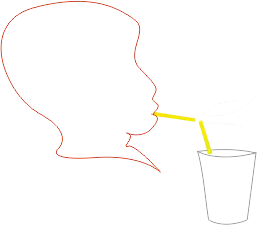
ACTIVITY 4
Place the ball in the funnel. Tilt your head back and point the wider end of the funnel upwards toward the ceiling or sky. Note: For health reasons only one student should blow into the funnel. Blow air forcefully through the narrow end of the funnel in an attempt to lift the ball out of the funnel. Observe and record what happens. Now, with the ball in the funnel as before, hold the funnel in front of you and blow forcefully across the top of the wider end of the funnel.
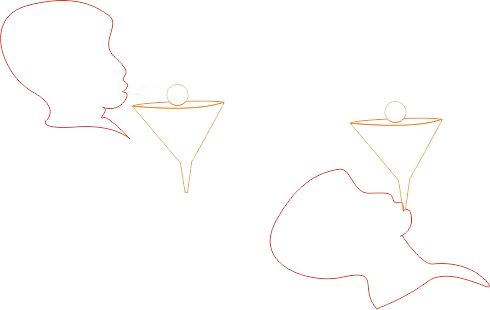
Science project Bernoulli's Principle Experiment
2. Explain Bernoulli’s effect.
As the speed of the air increases, its pressure decreases. Even when air is just sitting around, it still has pressure. That’s called static pressure, and it’s due to the weight of the air pressing down.
Rationale:
Motion of fluids is an important phenomenon and the study of fluid dynamics has enabled scientists to advance in many areas of technology. The taking off of aeroplanes and helicopters, the designing of high-speed vehicles, ships and submarines are some of the applications based on the knowledge of fluid flow. When vehicles move at high speed they tend to pull objects towards them, this can also be explained by the same concept. This lesson will enable learners to understand the principle behind the designing and operation of some of these devices.
Prerequisite/ Previous knowledge:
Definition of speed and fluid.Existence of atmospheric pressure,
Learning Materials:
Foolscaps/plane sheets of paper, 2 ball pen casings, water in a beaker, spray gunReference Materials:
Senior Secondary Physics. By P. N. Okeke and M. W. AnyakohaLesson Development:
| STAGE | TEACHER'S ACTIVITY | LEARNER'S ACTIVITY | LEARNING POINTS |
|---|---|---|---|
| INTRODUCTION full class session (5mins) |
The teacher asks the learners definition of fluid. | The learners define fluid and give examples of fluids. (Minds-on activity). A substance that flows — usually a LIQUID or a GAS. |
Linking previous knowledge with the lesson |
| STEP 1 10 mins. Development |
Activity 1Teacher poses a question on activity 1.Hold a piece of paper in front of your mouth and blow air over it.
|
The learners hold a piece of paper in front of the mouth and blow over it. (Hand-on activity). Learners explain the reason the paper rises. |
Predictions (exploration) The paper rises on blowing above it. Confirmation of their predictions from the activities’ results. Pressure above the paper reduces. |
| STEP 2 10 mins. |
Activity 2Teacher poses a second question on activity 2.Fold the paper in half to make a paper tent. Place the paper tent on a flat surface such as a table or a desk and blow air between them.
|
Learners predict. (Minds-on activity). |
Predictions (exploration) Predictions (exploration) Identification of the relationship between pressure and speed of air Increase in the speed of air causes the pressure to reduce. |
| STEP 3 Group Work (5 mins) |
Guide the Students to form four groups and ask them to choose their leaders and secretaries. | Learners form four groups and choose their leaders and secretaries. | Inculcating leadership skills, boldness, competitive spirit, teamwork, and a sense of responsibility among students. |
| STEP 4 5 mins |
Activity 3Teacher poses the third question on activity 3.Place two ballpoint casings perpendicular to one another with the erect one dipped in the water contained in a beaker (see diagram shown below). Blow air through the horizontal ballpoint case. (The blowing should be hard).
|
Learners go into groups to do activity 3. Learners blow hard through the horizontal narrow tube which is held perpendicularly to a vertical tube inserted in water. (Hands-on activity). Learners expand their ideas on the concept through group discussion. (Minds-on activity). Learners record and explain their observations in a group worksheet. Learners report and explain their observations to the other learners on the chalkboard. Learners harmonize their ideas guided by the teacher. (Bridging the activity to the concept: deductive bridge). |
The water jets out in a spray. Application of the relationship between speed of air and pressure. Recording the observations Interpretation of the observation on the phenomenon |
| EVALUATION 3mins |
The teacher evaluates the lesson by pausing a question to the learners on activities.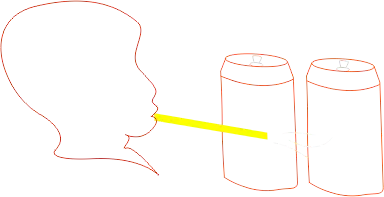
Place the two soda cans parallel to one another and 3/4 of an inch apart on a flat surface such as a table or desk. |
|
Asking the learners questions to assess the achievement of the set objectives. |
| CONCLUSION 2mins |
The teacher wraps up from the learners' observations. | Learners revise the three activities and relate them to the concept. Learners identify the applications of Bernoulli’s Effect in their daily life experiences. |
Application of Bernoulli’s Effect (spray guns, Pulling effect due to a big lorry passing by) |
| ASSIGNMENT | The diagram below shows a spray gun. Explain how it works.
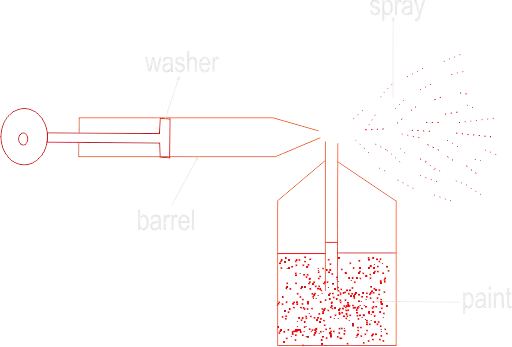
|
Learners answer other questions. | Improving their level of understanding of Bernoulli’s Effect. |